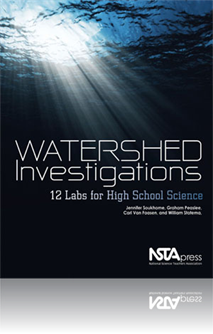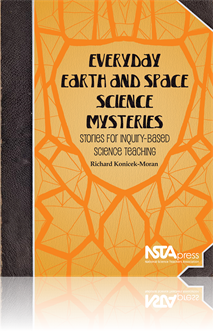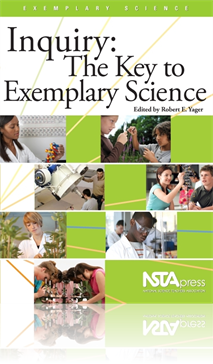All Book Chapters
Book Chapter
Streamflow, or discharge, is defined by the U.S. Geological Survey (USGS) as the volume of water flowing past a fixed point in a fixed unit of time. The discharge of a stream can be affected by many things, including topography and channel morphology...
Book Chapter
Flood Frequency Analysis for a River
In many watersheds, the frequency of flooding has greatly increased in the past 20 years, mainly due to changes in the hydrology as a result of farming and urbanization. Human habitation of floodplains causes floods to be perceived as destructive, bu...
Book Chapter
Comparison of Phosphate Levels in Stream Sediments
Phosphorus is an important nutrient to all life. Unfortunately, when phosphate reaches the soil it is not all used up by the plants. If excess phosphate enters the waterways in the watershed, it can cause increased plant growth in lakes and streams a...
Book Chapter
The study of science at the extremes of size often involves creating and testing models of science phenomena. Scientists and engineers often build models at different sizes and scales. These models can be physical, such as a Styrofoam ball model of t...
Book Chapter
Your World or Mine? Different Perspectives
Is the glass half-empty or half-full? That depends on your perspective. Differences in vantage point or prior knowledge can lead to different interpretations or conclusions. Scientists also have various perspectives on new discoveries or the results ...
Book Chapter
Eye in the Sky: An Introduction to GIS & Scale
New computer technologies allow us to examine scientific data at a variety of different scales from global to local. In this investigation students use Geographic Information Systems (GIS) as a tool to investigate different questions related to the e...
Book Chapter
Drops to the Ocean: A GIS Study of River Basins
Water is a critical element of life. It plays a crucial role at many scales from singles cells to huge river systems. In this investigation, students explore local, regional, and global river basins using GIS as a tool. The study begins with an exami...
Book Chapter
As science extends into the very large and the very small ends of the scale, the images of objects and materials lose recognizable contexts and can be very complex. New advances in microscopes and telescopes allow us to zoom in on very tiny and very ...
Book Chapter
That’s Hot! The Effect of Size on Rate of Heat Loss
Through the use of common household items such as aluminum pans and thermometers, students will investigate how the size and shape of an object affect the rate of heat loss from the object to the environment. This lesson is relevant to biology, as it...
Book Chapter
Sweet! Exploring Surface Area of Sugar Molecules
Two forces that are very familiar to us in our daily lives are gravity and adhesion. The force of gravity on an object, which we commonly refer to as the object’s weight, is proportional to the volume of the object. Adhesion or stickiness, on the o...
Book Chapter
Captivating Cubes: Investigating Surface Area-to-Volume Ratio
In this two-part activity, students investigate how surface area-to-volume ratios change with cube size. Students apply those calculations to explore how surface area-to-volume relationships limit the size of cells. Extensions of these activities pro...
Book Chapter
In this two-part activity, students make inferences about the relationships between egg size, incubation time, and bird size from data sets collected from hundreds of species of birds. Students will also investigate how an egg can exchange oxygen and...
Book Chapter
Could a bug ever be the size of a Volkswagen Beetle? Could a dragonfly be larger than a seagull? Movies often portray huge creatures that roam the Earth and sometimes terrorize humans. Could these scenarios actually happen, and if so, how? This activ...
Book Chapter
Across the different sciences one of the common challenges that researchers encounter is defining and measuring different variables. An essential part of that process is creating and using scales. In this investigation, students learn about a range o...
Book Chapter
Flying Foam: The Scale of Forces
The forces that are important for very large objects can be quite different than the forces that are important for very small objects. A planet is essentially unaffected by all but the gravitational force, whereas a molecule experiences mostly chemic...
Book Chapter
The same material may behave differently at different scales. These variations can become critical in understanding science at very large or very small scales. In this investigation, students use Styrofoam to explore how changes in size affect electr...
Book Chapter
Fractals: Self-Similar at Different Scales
Fractal geometry enables researchers to analyze complex shapes of natural objects and compare one system to another. It helps us define structure in new and useful ways. Moreover, if an object in a geological or biological context has fractal geometr...
Book Chapter
Screening My Calls: Scale and the Electromagnetic Spectrum
Light is just one type of electromagnetic radiation; it belongs to the visible portion of the electromagnetic (EM) spectrum. The other regions of the EM spectrum include everything from gamma rays to radio waves. They are all the same thing: electrom...
Book Chapter
Stringy Chemistry and States of Matter
Solids, liquids, and gases are familiar to students as the different states of matter. Why are some substances gases and some solid at room temperature? This exercise helps students explore the basic concepts behind intermolecular bonding and how it ...
Book Chapter
Our sensory organs are finely tuned instruments that not only detect but also measure different environmental inputs. In particular, our eyes, ears, and nose are extraordinary sensors. The tasks these organs face are incredibly challenging. Typical l...
Book Chapter
Beetlemice Multitudes!!! Power Law and Exponential Scaling
Scaling describes how a quantity changes over time or with the size of a system. It can also be defined as how a quantity changes in relation to any other parameter. When you stop and think about it, all of the equations in math and science are scali...
Book Chapter
Oops, I Did It Again: Errors in Measurement
Understanding the precision and accuracy of measurements is a crucial skill that scientists must develop to do their work. All measurements involve some degree of error. Knowing how to assess and work with error is an essential part of making sense o...
Book Chapter
Is a virus bigger than a bacterium? Is the distance from the Earth to the Moon greater than the diameter of the Earth? In this investigation, students explore the relative sizes of things through a card-sorting activity. The goal is to raise students...
Book Chapter
It’s Not All Relative: Relative Versus Absolute
Learning about the sizes of things and scale engages students in thinking about conceptual benchmarks for sizes. In this investigation, students learn to order objects on a relative scale, as well as to accurately label actual or absolute sizes. In a...
Book Chapter
Time Flies When You’re Learning About Scale!
Not many students would forget to say “Dinosaurs!” if you mention the Jurassic period, yet the word scale only conjures up ideas of measuring objects. Most students automatically think of measuring mass, volume, or distance, and not necessarily t...
Book Chapter
Billions of Us: Scale and Population
Population is increasingly important as both a scientific and a political subject. The world is getting more crowded. Providing students with the tools to understand population numbers is not only important for their basic understanding of their worl...
Book Chapter
When building a dollhouse or a model of a car or a cell, close attention to the details is crucial to making it look accurate and realistic. A consistent scaling factor for all details in the model is critical. In this activity, students explore scal...
Book Chapter
This story obviously is aimed at the technology standards. Two simple timing devices are mentioned with the suggestion that more are possible. These can be improved to meet the challenge or other devices could be invented. Students are being challeng...
Book Chapter
The two concepts at work here are conservation of matter and the question about many surfaces vs. fewer surfaces absorbing heat. You may wonder what this story is doing in the Earth system science area, but it has to do not only with thermodynamics a...
Book Chapter
Inquiry at the Ocean Research College Academy (ORCA)
The Ocean Research College Academy (ORCA) is a full-time, dual credit, early college program designed exclusively for Washington State Running Start (juniors and seniors in high school) students. Students in ORCA are together as a cohort for two year...
Book Chapter
Science Projects: Successful Inquires in Eighth-Grade Science
This chapter focuses on the mission of the science department of Hilo Intermediate School—to ensure that the Hawaii State Standards and Benchmarks are addressed through the seventh-grade life science and eighth-grade Earth and space science classes...
Book Chapter
Inquiry Is Elementary: Differing Approaches to Inquiry Within Two Elementary Schools
Scientific inquiry is practiced and celebrated at two elementary schools within a school district of 40,000 students, located within a first ring suburb of Minneapolis. While their approach to inquiry differs somewhat, the commitment to inquiry learn...
Book Chapter
Science as Inquiry at Sir Winston Churchill Collegiate and Vocational Institute
As a department, the science teachers at Sir Winston Churchill Collegiate and Vocational Institute share a common commitment to the ideals of teaching of science as inquiry. As individuals, they also have the flexibility to teach in ways that reflect...
Book Chapter
Erasing Lecture-Laboratory Boundaries: An Inquiry-Based Course Design
The University of Maine at Presque Isle (UMPI) is one of seven autonomous campuses within the University of Maine System. UMPI combines liberal arts and selected professional programs for 1,400 undergraduates and also serves as a cultural and educati...
Book Chapter
Enhancing the Inquiry Experience: Authentic Research in the Classroom
Inquiry in science classrooms involves the ability to pose a question, explore phenomena relating to the question, acquire new understandings, communicate new ideas, and relate or compare ideas with what other scientists have found (NRC 2000). The En...
Book Chapter
Ecological Monitoring Provides a Thematic Foundation for Student Inquiry
The Project in Hawaii’s Intertidal (OPIHI) is a network of schools and scientist volunteers engaged in the widespread, systematic monitoring of Hawaii’s rocky intertidal zones. OPIHI originated through a partnership funded by the National Science...
Book Chapter
“If We Are Supposed to Understand Science, Shouldn’t We Be Doing It?”
The author’s teaching career, like many others, began teaching high school in a basic science classroom where the students asked this chapter’s title question. But if students were going to be successful in inquiry-based science, these new ways o...
Book Chapter
Inquiry: A Challenge for Changing the Teaching of Science in Connecticut
A catalyst for inquiry gaining its rightful place of importance in Connecticut public education was the State Board of Education’s 2004 adoption of the Core Science Curriculum Framework (CSDE 2004). The framework includes a set of inquiry standards...
Book Chapter
Learning Science With Inquiry in the Clark County School District
In 2005, Project PASS—Proficiency And Success in Science—was funded as a Mathematics and Science Partnership by the Nevada Department of Education. This three-year collaborative project was initiated with the goals of improved quality of instruct...
Book Chapter
Natural Scientists: Children in Charge
This chapter discusses how the authors refined their teaching practices to allow young children to begin to develop inquiry process skills. In previous years, the process skills of science were addressed because educators felt they were vital to all ...






